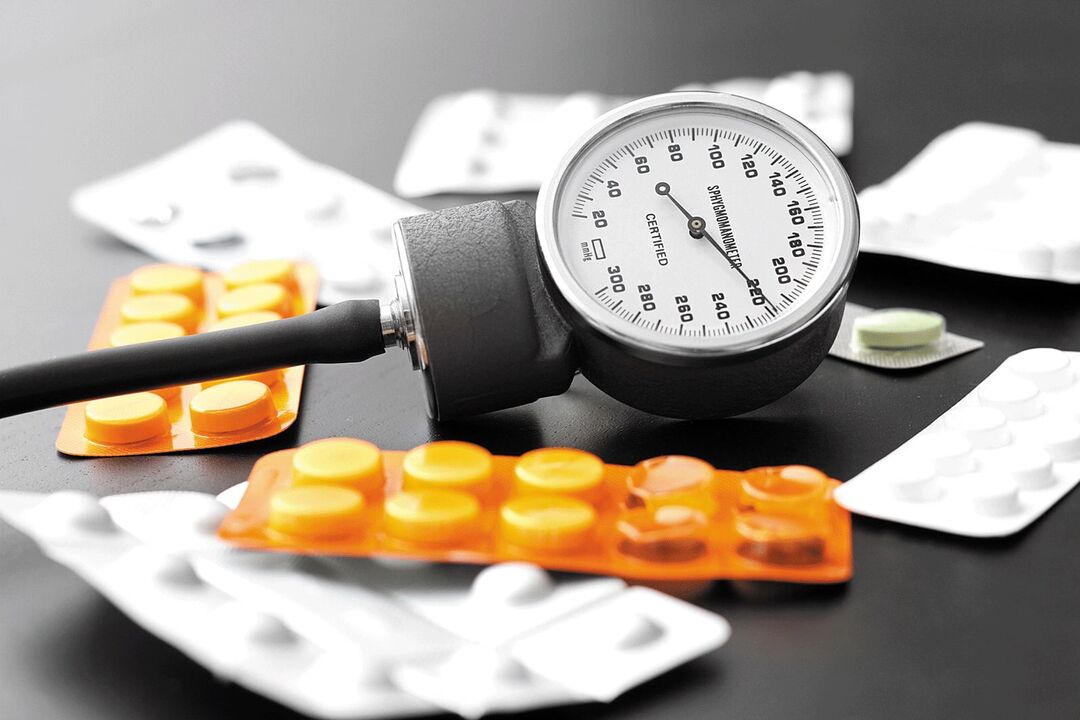A diagnosis of hypertension is considered only when there is a persistent rise in blood pressure on the face or frequent jumps. At the same time, different stages of hypertension manifest themselves with different forces. In the early stages of the disease, people are usually unaware of the development of problems. Sometimes, even a slight rise in temperature is more important than the deterioration of the condition during the development of arterial hypertension. The pathological types differ in the severity of the symptoms and the presence of accompanying disorders in the body. In fact, even in the absence of obvious symptoms, high blood pressure is no less dangerous than completing various disorders in the body. Symptoms of hypertension include limb tremors, nausea, headache, and flies in front of the eyes. All symptoms develop due to problems with blood flow to internal organs.

Stages of hypertension
The clinical picture of hypertension is divided into stages and severity according to the impact on the whole body and the severity of the accompanying symptoms. There are 3 stages. The division into stages helps the doctor to systematize the diagnostic information obtained and choose the right tactics to correct the patient's condition.
1st stage
In stage 1 hypertension, the blood pressure level does not exceed 159/99. This increase may take several days. Rest will help to normalize blood pressure and relieve stress. It will not be easy to restore blood pressure as the pathology progresses.
At this stage of the disease, there are no symptoms affecting the target organs. For this reason, arterial hypertension is often asymptomatic. Only sometimes sleep is disturbed, hidden headaches and heart pain may develop.
At the time of clinical diagnosis, a slight increase in the tone of the fundus arteries may be detected. In the early stages of the disease, the risk of hypertensive crisis is minimal, often only due to the influence of external conditions on the body. Women are also at increased risk during menopause. The initial stage responds well to treatment. It is usually enough to change your lifestyle. Medications are not always needed. With timely therapy and strict adherence to the doctor's instructions, the prognosis will be favorable.
Stage 2
This is the stage of active pathological changes in the blood vessels - severe hypertension. In the second stage, the pressure reaches 179/109. Rest does not restore its level. One person complains of unbearable headaches, shortness of breath during tension, poor sleep, dizziness and increased heart rate.
This stage is characterized by the development of the first symptoms from the internal organs. The most common symptoms of severe hypertension are:
- signs of left ventricular hypertrophy;
- narrowing of the lumen of the arteries of the retina;
- increase in blood cholesterol;
- presence of protein in the urine.
Stage 2 hypertension significantly increases the risk of dangerous complications that can result from stroke. Without regular medical treatment, it will not work.
3 stages
This is a stage of disorders in the target organs due to pathological changes in the blood vessels and disruption of blood flow throughout the body. Very severe hypertension in stage 3. The last stage of hypertension is the most severe, extensive disorders that develop in the body and affect the target organs. The eyes, kidneys, brain and heart are most affected. In stage 3, the pressure is stable and even difficult to normalize with medication. There are often jumps up to 180/110 mm Hg. Art. and more. The symptomatology is similar to that of stage 2, but is accompanied by pathological manifestations from the affected organs. Memory often deteriorates, heart rate is severely impaired, visual acuity is reduced.
This stage is always dangerous because it affects the heart. Its contractility and conduction of impulses in the myocardium are impaired.
Degrees
With the increase in blood pressure and the lack of effect of the measures taken, it can be assumed that the disease progresses. The optimal blood pressure level is 120/80. The norm for systolic pressure is 120 to 129, and diastolic is 80 to 84. When a person feels well, there is a high normal pressure - up to 139/89 mm Hg. Art. In medicine, hypertension is divided into 3 degrees.
I degree
Grade 1 arterial hypertension is mild, characterized by a drop in blood pressure and fluctuations from 140/90 to 159/99. In this case, the risk of crisis is minimized, there are no signs of dysfunction of other organs and central organs. nervous system. To suppress the attack, in addition to taking special pills, you should rest a bit, try to avoid stress, walking and positive emotions have a beneficial effect on health.

If systolic pressure does not rise above 159 and diastolic does not exceed 99 mm Hg. Art. , then the person is diagnosed with mild hypertension - first degree. It is characterized by the following symptoms:
- severe headaches;
- stabbing left in the chest, painful sensation, spreads to the shoulder blade and under the arm;
- severe dizziness that may cause fainting;
- accelerating the heartbeat;
- black flies;
- tinnitus;
- sleep disorders.
If a person is constantly developing, he stops seeing the listed symptoms. An attack of hypertension can begin under the influence of stress and is ineffective with the necessary help.
II degree
Grade 2 hypertension begins to develop more actively. The pressure level already reaches 160/100 - 179/109. Symptoms of a hypertensive crisis develop - cold sweats appear, gases appear on the skin, the skin becomes red.
Symptoms of grade 2 disease include:
- transient cerebral ischemia - deterioration of blood flow to the body;
- increase in blood creatinine concentration;
- narrowing of blood vessels in the retina;
- increase in the size of the left ventricle;
- protein in urine detected during test delivery;
- persistent fatigue;
- nausea;
- pulsation at first;
- swelling of the face;
- severe sweating;
- damage to internal organs;
- numbness of fingers;
- blurred vision;
- crises.
Medications are not well understood with the normalization of the patient's condition. Doctors pay attention not only to the level of pressure, but also to the rate of development of the disease. Secondary hypertension affects the kidneys. The patient almost always complains of weakness.
III degree
Grade 3 hypertension is the most severe. When it occurs, vision is sharply reduced, memory deteriorates, tachycardia often occurs, and the risk of hypertensive crisis is high. Complications include thrombosis, encephalopathy, aneurysms, renal and left ventricular failure, bruising throughout the body, and swelling of the optic nerve. Pathology is irreversible. Patients with grade 3 hypertension definitely need outside help and care. The main symptoms of hypertension are:
- arrhythmia;
- gait instability;
- significant visual impairment;
- stimulates blood flow to the brain, paresis and paralysis;
- crisis accompanied by confusion and speech disorders;
- acute heart pain;
- blood expectoration;
- restriction of mobility and self-service;
- inability to communicate properly.
These symptoms indicate the progression of hypertension and the involvement of new organs in the disease. Gradually more and more irreversible complications develop.
Classification by risk factors
Hypertension is primarily dangerous for its numerous and often irreversible complications. Most patients become disabled or die not from high blood pressure, but from acute disorders caused by other organs.
The most dangerous conditions are ischemic necrosis, cerebral hemorrhage, heart attack, kidney failure. To prevent various complications associated with dysfunction of other organs, the doctor determines the degree of risk during the examination. Risk levels are indicated by numbers from 1 to 4. It turns out that the diagnosis contains information about the degree and risk of damage, for example, GB 2 degree, risk 4.
Low risk (negligible)
This risk indicator for the development of complications of hypertension is observed in women under 65 years of age and men under 55 years of age with mild hypertension in stage 1. Over the next 10 years, only 15% of people develop additional cardiovascular disease due to hypertension. These patients are usually seen by general practitioners, as it is pointless to visit a cardiologist and apply serious treatment.
While the small risks still persist, the person should make lifestyle changes in the next 6 months. This will lead to positive developments. If there are no results and it is not possible to achieve a reduction in blood pressure, it is recommended to change the patient's management tactics and implement drug treatment.
Moderate risk
This group of patients includes hypertensive patients with blood pressure readings not exceeding 179/110. As a rule, these people have 1-2 risk factors:
- to smoke;
- genetics;
- obesity;
- high cholesterol concentration;
- lack of physical activity;
- impaired glucose tolerance.
Over the next 10 years, 20% of cases develop dangerous cardiovascular pathologies. Organizing a healthy lifestyle is an integral part of health care. Medications may not be prescribed for 3-6 months so that the patient can change his lifestyle and recover as much as possible.
high risk
This risk group includes patients with a score of 179/110 or higher in the presence of more than 2 predisposing factors. There is also a high risk for people with target organ damage, diabetes mellitus, retinal vascular disorders and atherosclerosis.
There may be no risk factors, but people with stage 3 hypertension are already at high risk. They must be treated by a cardiologist. The risk of complications is 30%. Lifestyle normalization is used only as an additional tactic against the background of taking specially selected drugs. The selection of the most effective drugs should be made as soon as possible.
Treatment approaches
The main goals of treatment of hypertension are to reduce blood pressure and prevent consequences. Full recovery is not possible, but stage and adequate treatment can help stop the active progression of the pathology and minimize the risk of hypertensive crisis.
Drug therapy usually involves the use of antihypertensive drugs that inhibit the production of norepinephrine and its vasomotor activity. At the same time, diuretics, antiplatelet agents, hypoglycemic, hypolipidemic and sedative drugs are required. In the absence of the expected result, the combined effect of several antihypertensive drugs occurs simultaneously.
In a hypertensive crisis, it is necessary to reduce the pressure within an hour after the attack, otherwise the risk of dangerous complications and death increases. In this case, antihypertensive drugs are used by injection or drip.

Regardless of the degree and stage of dysfunction of the body, an important method of therapy is the normalization of nutrition, adherence to a special diet. The diet definitely includes foods enriched with magnesium, potassium and vitamins. It is necessary to limit the use of salt, avoid alcohol, fried and fatty foods. With obesity, the daily caloric content of the diet is reduced, and sugar, pastries and other confectionery are prohibited.
People with hypertension benefit from moderate physical activity - exercise therapy, swimming, walking. Therapeutic massage also has a positive effect on well-being with hypertension. Smoking is strictly forbidden, you need to develop resistance to stress with psychotherapeutic practices and relaxation techniques.
The effectiveness of complex therapy is assessed by several criteria:
- The short-term goals are to normalize the pressure to the level at which the patient feels well.
- The medium-term goals are to prevent the occurrence and active development of pathologies in the target organs.
- Long-term goals are to prevent complications and prolong the patient's life.
Hypertension is a disease that is easier to prevent than to fight for a lifetime, trying to alleviate the symptoms and prevent the systemic deterioration of the condition. The sooner the diagnosis is made and the stage of hypertension is determined, the more effective the treatment will be.



























